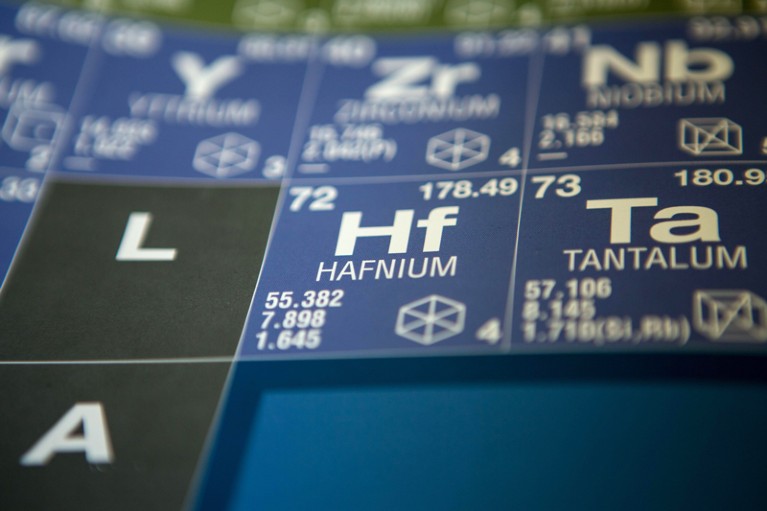A century ago, the discovery of hafnium confirmed the validity of the periodic table — but only thanks to scientists who stood up for evidence at a time of global turmoil.

Hafnium isn’t a particularly remarkable element. It’s not your explosive sodium, shimmering mercury or stinky sulfur. It’s a greyish metal and is commonly used as a neutron absorber in the control rods of nuclear power plants and nuclear submarines, and as an insulator in computer chips. But hafnium’s discovery, which was reported in Nature a century ago this week1, was of disproportionate importance. The element was identified by two scientists working in Copenhagen: Dutch physicist Dirk Coster and Hungarian chemist Georg von Hevesy. The find secured not only the periodic table’s legacy but also the future of chemistry. Hafnium also came to represent a hard-won victory against those determined to undermine evidence-based discovery.
Dmitri Mendeleev’s periodic table of elements, created in 1869, emerged from the realization that chemical elements such as oxygen and hydrogen share certain relationships. Mendeleev’s contribution, and that of the German chemist Julius Lothar Meyer, working independently, provided an order for the elements, along with criteria for classifying them into neat groups. Remarkably, both Mendeleev’s and Lothar Meyer’s schemes were based on elements’ subatomic structure — several decades before the discovery of electrons and protons.
When Mendeleev devised the periodic table’s rough form, he started with 63 known elements. To make the table work, he had to leave gaps where as-yet undiscovered elements might be placed. These elements soon began to turn up. For example, the predicted ‘element 68’, gallium, was identified a few years later, in 1875. By 1914, just seven gaps remained.
A breakthrough occurred in 1913, when Henry Moseley, a British physicist, showed that elements could be arranged by their atomic number, or their number of protons. Moseley’s work provided both a more accurate ‘gap map’ and a method for identifying elements from the spectra produced by exposing candidate elements to X-rays.The battle behind the periodic table’s latest additions
But the discovery (and naming) of element 72, hafnium, was anything but straightforward. The French chemist Georges Urbain originally proposed, in 1911, that element 72 belonged among the periodic table’s rare earth elements, and named it celtium. But around a decade later, the Danish physicist Niels Bohr — who used quantum theory to develop a model of the atom in which electrons orbit the nucleus — predicted that element 72 would be among the transition metals, and closer to zirconium (element 40). This was finally confirmed by Coster and von Hevesy — both working at Bohr’s lab in Copenhagen — who searched zirconium minerals for the element2. The duo named their discovery hafnium, after the Latin name for Copenhagen. They obtained the X-ray spectra in December 1922 and their paper1 followed in January 1923.
But this was far from the end of the controversy, because Urbain stubbornly refused to give up, even though he had already had warning that the material he called celtium did not conform to the criteria for element 72. In 1914, Moseley and Urbain had collaborated on an unpublished X-ray study that failed to show that celtium was element 72. Urbain explained this away, saying that the X-ray method was simply not sensitive enough3 — an assessment that the New Zealand-born physicist Ernest Rutherford, writing in Nature, agreed with4. Urbain also suggested that the Copenhagen team were trying to take credit for his work5; in their response, Coster and von Hevesy refused to personalize the dispute and argued on the basis of their results6.
Debate continued, with scientists from the Netherlands, Germany and Scandinavia on the side of the Copenhagen team, while those from France and the United Kingdom (who were backing a boycott of German science in the wake of the First World War) took the counter position. Hafnium was accepted by the International Union of Pure and Applied Chemistry only in 1930, a few years after the boycott formally ended. In France, celtium continued to occupy the place of element 72 among the rare earth elements until the early 1940s2.
One hundred years on from hafnium’s discovery, the periodic table remains both robust and relevant, even at a time when reams of data on an element can be accessed at the click of a mouse. The table offers, at a glance, a reference to how an element might behave in a chemical reaction, and clues to its similarity to other elements in a group.
So far, there are 118 confirmed elements, with the addition of four superheavy synthetic elements in 2015. But a time will surely come when there will be no new elements to make and the periodic table will reach its limits. As yet there is no consensus on when this is likely to happen or how big the last element will be, but chemists say its atomic number could exceed 170.
When that time comes, the periodic table will still remain, a map guiding scientists through the vastness of chemical space — all the molecules that have ever formed, and all those yet to be discovered, whether on Earth or elsewhere in the Universe. It’s a tribute to the enduring values of international scientific cooperation and the steadfastness of researchers that an unremarkable transition metal, discovered 100 years ago in the aftermath of one of the world’s greatest conflicts, made the periodic table what it is today.
Nature








